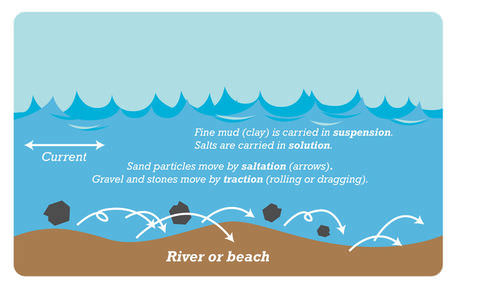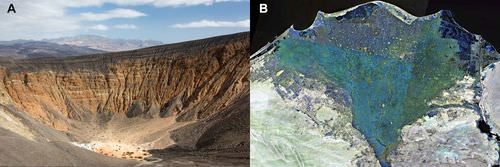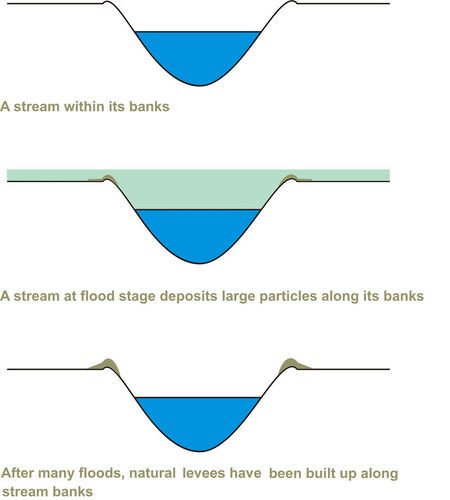14.2: Deposition by Streams
- Page ID
- 5564
\( \newcommand{\vecs}[1]{\overset { \scriptstyle \rightharpoonup} {\mathbf{#1}} } \)
\( \newcommand{\vecd}[1]{\overset{-\!-\!\rightharpoonup}{\vphantom{a}\smash {#1}}} \)
\( \newcommand{\dsum}{\displaystyle\sum\limits} \)
\( \newcommand{\dint}{\displaystyle\int\limits} \)
\( \newcommand{\dlim}{\displaystyle\lim\limits} \)
\( \newcommand{\id}{\mathrm{id}}\) \( \newcommand{\Span}{\mathrm{span}}\)
( \newcommand{\kernel}{\mathrm{null}\,}\) \( \newcommand{\range}{\mathrm{range}\,}\)
\( \newcommand{\RealPart}{\mathrm{Re}}\) \( \newcommand{\ImaginaryPart}{\mathrm{Im}}\)
\( \newcommand{\Argument}{\mathrm{Arg}}\) \( \newcommand{\norm}[1]{\| #1 \|}\)
\( \newcommand{\inner}[2]{\langle #1, #2 \rangle}\)
\( \newcommand{\Span}{\mathrm{span}}\)
\( \newcommand{\id}{\mathrm{id}}\)
\( \newcommand{\Span}{\mathrm{span}}\)
\( \newcommand{\kernel}{\mathrm{null}\,}\)
\( \newcommand{\range}{\mathrm{range}\,}\)
\( \newcommand{\RealPart}{\mathrm{Re}}\)
\( \newcommand{\ImaginaryPart}{\mathrm{Im}}\)
\( \newcommand{\Argument}{\mathrm{Arg}}\)
\( \newcommand{\norm}[1]{\| #1 \|}\)
\( \newcommand{\inner}[2]{\langle #1, #2 \rangle}\)
\( \newcommand{\Span}{\mathrm{span}}\) \( \newcommand{\AA}{\unicode[.8,0]{x212B}}\)
\( \newcommand{\vectorA}[1]{\vec{#1}} % arrow\)
\( \newcommand{\vectorAt}[1]{\vec{\text{#1}}} % arrow\)
\( \newcommand{\vectorB}[1]{\overset { \scriptstyle \rightharpoonup} {\mathbf{#1}} } \)
\( \newcommand{\vectorC}[1]{\textbf{#1}} \)
\( \newcommand{\vectorD}[1]{\overrightarrow{#1}} \)
\( \newcommand{\vectorDt}[1]{\overrightarrow{\text{#1}}} \)
\( \newcommand{\vectE}[1]{\overset{-\!-\!\rightharpoonup}{\vphantom{a}\smash{\mathbf {#1}}}} \)
\( \newcommand{\vecs}[1]{\overset { \scriptstyle \rightharpoonup} {\mathbf{#1}} } \)
\( \newcommand{\vecd}[1]{\overset{-\!-\!\rightharpoonup}{\vphantom{a}\smash {#1}}} \)
\(\newcommand{\avec}{\mathbf a}\) \(\newcommand{\bvec}{\mathbf b}\) \(\newcommand{\cvec}{\mathbf c}\) \(\newcommand{\dvec}{\mathbf d}\) \(\newcommand{\dtil}{\widetilde{\mathbf d}}\) \(\newcommand{\evec}{\mathbf e}\) \(\newcommand{\fvec}{\mathbf f}\) \(\newcommand{\nvec}{\mathbf n}\) \(\newcommand{\pvec}{\mathbf p}\) \(\newcommand{\qvec}{\mathbf q}\) \(\newcommand{\svec}{\mathbf s}\) \(\newcommand{\tvec}{\mathbf t}\) \(\newcommand{\uvec}{\mathbf u}\) \(\newcommand{\vvec}{\mathbf v}\) \(\newcommand{\wvec}{\mathbf w}\) \(\newcommand{\xvec}{\mathbf x}\) \(\newcommand{\yvec}{\mathbf y}\) \(\newcommand{\zvec}{\mathbf z}\) \(\newcommand{\rvec}{\mathbf r}\) \(\newcommand{\mvec}{\mathbf m}\) \(\newcommand{\zerovec}{\mathbf 0}\) \(\newcommand{\onevec}{\mathbf 1}\) \(\newcommand{\real}{\mathbb R}\) \(\newcommand{\twovec}[2]{\left[\begin{array}{r}#1 \\ #2 \end{array}\right]}\) \(\newcommand{\ctwovec}[2]{\left[\begin{array}{c}#1 \\ #2 \end{array}\right]}\) \(\newcommand{\threevec}[3]{\left[\begin{array}{r}#1 \\ #2 \\ #3 \end{array}\right]}\) \(\newcommand{\cthreevec}[3]{\left[\begin{array}{c}#1 \\ #2 \\ #3 \end{array}\right]}\) \(\newcommand{\fourvec}[4]{\left[\begin{array}{r}#1 \\ #2 \\ #3 \\ #4 \end{array}\right]}\) \(\newcommand{\cfourvec}[4]{\left[\begin{array}{c}#1 \\ #2 \\ #3 \\ #4 \end{array}\right]}\) \(\newcommand{\fivevec}[5]{\left[\begin{array}{r}#1 \\ #2 \\ #3 \\ #4 \\ #5 \\ \end{array}\right]}\) \(\newcommand{\cfivevec}[5]{\left[\begin{array}{c}#1 \\ #2 \\ #3 \\ #4 \\ #5 \\ \end{array}\right]}\) \(\newcommand{\mattwo}[4]{\left[\begin{array}{rr}#1 \amp #2 \\ #3 \amp #4 \\ \end{array}\right]}\) \(\newcommand{\laspan}[1]{\text{Span}\{#1\}}\) \(\newcommand{\bcal}{\cal B}\) \(\newcommand{\ccal}{\cal C}\) \(\newcommand{\scal}{\cal S}\) \(\newcommand{\wcal}{\cal W}\) \(\newcommand{\ecal}{\cal E}\) \(\newcommand{\coords}[2]{\left\{#1\right\}_{#2}}\) \(\newcommand{\gray}[1]{\color{gray}{#1}}\) \(\newcommand{\lgray}[1]{\color{lightgray}{#1}}\) \(\newcommand{\rank}{\operatorname{rank}}\) \(\newcommand{\row}{\text{Row}}\) \(\newcommand{\col}{\text{Col}}\) \(\renewcommand{\row}{\text{Row}}\) \(\newcommand{\nul}{\text{Nul}}\) \(\newcommand{\var}{\text{Var}}\) \(\newcommand{\corr}{\text{corr}}\) \(\newcommand{\len}[1]{\left|#1\right|}\) \(\newcommand{\bbar}{\overline{\bvec}}\) \(\newcommand{\bhat}{\widehat{\bvec}}\) \(\newcommand{\bperp}{\bvec^\perp}\) \(\newcommand{\xhat}{\widehat{\xvec}}\) \(\newcommand{\vhat}{\widehat{\vvec}}\) \(\newcommand{\uhat}{\widehat{\uvec}}\) \(\newcommand{\what}{\widehat{\wvec}}\) \(\newcommand{\Sighat}{\widehat{\Sigma}}\) \(\newcommand{\lt}{<}\) \(\newcommand{\gt}{>}\) \(\newcommand{\amp}{&}\) \(\definecolor{fillinmathshade}{gray}{0.9}\)Why is there a pile of rocks in that stream?
A river meanders, causing erosion on one side of its bank. On the other side, sediments are deposited. In this photo of a meander, where is there erosion and where is there deposition?
Sediment Transport
Sediments move differently when carried by water, depending on their size; this is illustrated below (Figure below).
How flowing water moves particles. How particles are moved by flowing water depends on their size.
Sediments are carried as:
- Dissolved load: Dissolved ions are carried in the water. These ions usually travel all the way to the ocean.
- Suspended load: Sediments carried as solids as the stream flows are suspended load. The stream's velocity determines the size of particles that can be carried (Figure below).
The Connecticut River is brown from the sediment it carries. The river drops the sediment offshore into Long Island Sound.
- Bed load: Some particles are too large to be carried as suspended load. These sediments are bumped and pushed along the stream bed as bed load. Bed load sediments do not move continuously. This intermittent movement is called saltation. Streams with high velocities that flow down steep slopes cut down into the stream bed. The sediments that travel as bed load do a lot of the downcutting.
Deposition by Streams and Rivers
When a stream or river slows down, it starts dropping its sediments. Larger sediments are dropped in steep areas, but smaller sediments can still be carried. Smaller sediments are dropped as the slope becomes less steep.
Alluvial Fans
In arid regions, a mountain stream may flow onto flatter land. The stream comes to a stop rapidly. The deposits form an alluvial fan (Figure below).
(A) Alluvial fans in Death Valley, California (B) Nile River Delta in Egypt
Deltas
Deposition also occurs when a stream or river empties into a large body of still water. In this case, a delta forms. A delta is shaped like a triangle. It spreads out into the body of water. An example is pictured below (Figure above).
Deposition by Flood Waters
A flood occurs when a river overflows it banks. This might happen because of heavy rains.
Floodplains
As the water spreads out over the land, it slows down and drops its sediment. If a river floods often, the floodplain develops a thick layer of rich soil because of all the deposits. That’s why floodplains are usually good places for growing plants. For example, the Nile River in Egypt provides both water and thick sediments for raising crops in the middle of a sandy desert.
Natural Levees
A flooding river often forms natural levees along its banks. A levee (Figure below) is a raised strip of sediments deposited close to the water’s edge. Levees occur because floodwaters deposit their biggest sediments first when they overflow the river’s banks.
This diagram shows how a river builds natural levees along its banks.
Summary
- Streams carry dissolved ions and sediments. The sizes of the sediments a stream can carry, its competence, depend on the stream's velocity.
- Particles that are too large to be suspended move along the stream bed by saltation.
- Rivers deposit sediments on levees, floodplains, and in deltas and alluvial fans.
Review
- If the amount of water in a stream in flood starts to go down, what will happen to sediments the stream is carrying? What will be deposited and where?
- What happens when a river floods? How are natural levees created?
- How do alluvial fans form?
Explore More
Use this resource (watch up to 8:00) to answer the questions that follow.
- What type of structure is the Lighthouse? What is that?
- What is the rock that eroded away? Why was it removed?
- What did the canyon start out as? What happened to make the canyon?
- What rock type is most of the rock in this canyon? Why is that important?
- What is the river doing now?
- What is the major agent of erosion in the canyon? What is second?






